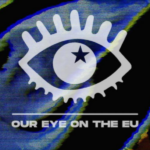
Article by Amerissa Giannouli
In the context of the Conference on the Future of Europe, we invited young people living in Greece to take part in the “Designing the Future of Europe” educational programme.
A group of 15 young people did an empirical – collective and individual – exploration of the idea of Europe in relation to their everyday lives and experiences.
Together, they discussed the European Union’s influence, the importance of understanding how the past and the perception of the present play into the future and identified ways and tools to contribute to shaping a common European future by making changes to the structures and issues that affect their lives today.
The programme was divided into five distinct but interrelated parts and applied methodologies inspired by futures literacy and the Futures Narratives project.
In the first part, participants got to know each other and participated in virtual discussions on particular thematic priorities that they were interested in. The thematic priorities included “young people and democracy”, “ecology and quality of life”, “human rights”, “education and technology” and “art and culture”.
In the second part, participants explored how the past (50-70 years ago) is connected to the present and the future. They used an activity called “Generations Chain” to analyse events, fears and aspirations of their grandparents, their parents, themselves and their children.
It seems that the priorities of each generation change according to the experiences and events that affect their lives. Some things that now may be perceived as given did not exist in the past. However, issues that should have been addressed already years ago are still challenging our lives. Moreover, there is a re-emergence of issues in the political and social scene and everyday life.
To have a glimpse of the past, participants were asked to develop an imaginary article, an online social media post that could have been made 50-70 years ago if there were social media like Facebook or Instagram. It is interesting to see how different the wording and photos used for the article might have been in the past. Then, the participants had to find people living 50-70 years ago and share their creations. They had to check if and how different their perceptions might have been compared to the actual experiences of people who lived 50-70 years ago.
Although there seem to be differences, the lives of each generation are connected and transfer information, experiences and other elements to the other, to the extent that it can affect and determine the future. If we want to imagine a new future, whether it is ideal or not, good or bad, it is necessary to look at things and situations more clearly, understanding how the past might have reflected in our present and it is possible to affect our future. Only by deconstructing the narratives and myths of the past, we allow space for reconstructing our present and building new narratives for the future.
In the third part, we talked about the changes that have been made concerning the past in politics, the economy, society, the natural environment, technology and legislation. The discussion focused on the thematic priorities and key elements that had already emerged from the first part of the programme.
In the fourth part, participants shared pictures from their everyday life, sharing moments that they like and they do not like. They tried to describe the present as they understand it and see it more clearly as a collage of pictures and moments of their interrelated lives. They were also asked to identify things that are likely to increase or decrease in the future. Then, each participant described on a piece of paper how they imagine their lives 20 years from now. The previous process helped them connect the trends, recognise the good and bad elements of the past that affect their everyday lives and imagine their ideal future. It was a very personal process that allowed them to set particular expectations and values for the future and open the discussion to what needs to be done in the present.
Divided into their preferred thematic priorities, each team described the problem they wish to challenge and the changes they want to make for reaching a desirable future. They analysed the problem using the Causal Layered Analysis, a method that introduces different levels in the analysis of a problem, focused in particular on the cultural aspects and societal narratives behind the problems. It was an in-depth analysis that led to interesting proposals about the future of Europe and how this is reflected in the local context of the participants. Below, you may read through their ideas and proposals that have been also uploaded in the Multilingual Digital Platform of the Conference on the Future of Europe.
Youth and democracy
Political participation must cover other things besides voting every four or five years. Youth education, “formal” (eg. public education), “non-formal” (eg. tutoring, extracurricular activities) and “informal” (eg. society, family) should encourage social participation. In the field of non-formal education, some actions aim to activate young people in society through volunteering, but they are not so politically oriented (perhaps, this is for good). However, formal structures play a very important role in shaping the culture and mentality. Weekly classroom dialogues on socio-political issues could be established. This could be a lesson on its own, where opinions will be exchanged and respected, communication skills will be developed and a sense of community will be further developed. Each person will learn and experience to be an active listener. Perhaps, current forms such as the school councils (“dekapentameles” in the Greek context) should be replaced with more direct democratic forms such as monthly consultations, where discussion topics are set freely and anonymously and where there are discussion moderators. Modern technological tools (e.g. Doodle poll, collaborative documents, etc.) allow expressing opinions whenever the participants want, anonymously, without the pressure of a live discussion where the opinion of the person that speaks louder than the rest or has done better “lobbying” is accepted.
Education
Education’s purpose should be self-improvement and intellectual development independent of career and labour market. Education is not just a process of entering the university or the labour market, but a pleasant and constructive process important for inner development and reflection on who we are and who we want to be. Education should be a lifelong learning process. At the local and national levels, alternative educational methods should be supported in the sense that exams will not be the only criterion for entering a university or passing a class. Education should cultivate humanitarian values to reduce discrimination while different ways of expression should be welcomed and respected. For example, education should promote respect for each professional career choice, while the labour market should not discriminate against particular social identities (eg. migrants, refugees, youth, women, people with disabilities, etc.).
Abortion rights
There should be a change in legislation on abortion, an increase in practical support and providing information on having children and avoiding unwanted pregnancies. It requires a new way of thinking that will allow the woman to be in control of her body and make her own life decisions, without the involvement of external factors. This will be achieved by raising awareness through social media and campaigning. Once the right to abortion is legalized, we will become familiar with this idea and choice that does not trap people in undesirable situations resulting in a deeply dysfunctional family. In this way, every woman will be given the opportunity to self-determination and a choice in a key issue for her life and the father of her child.
Environment and quality of life
The environmental factor should be the most important compared to financial profits and economic growth for the states and companies. This requires a change in the financial system (eg. sovereign money system), the labour market and the social security systems (eg. green jobs, fewer working hours, basic universal income). It may include reducing pollution and increasing the use of renewable energy sources, compulsory recycling of various types of waste (packaging, clothing, organic waste, electronics) by citizens and companies, changes in the way food and products are consumed, and the production of only sustainable products. Companies should decrease their carbon footprint to zero even if this means reducing their profits.
In the fifth and last part of the programme, participants had to develop stories connecting how they imagine themselves 20 years from now and how society might look if their proposals were adopted in the future. We asked them to write three things that they can do today or in the near future to reach their preferred future. Then, we asked them to think about who or what has a strong effect on their actions for the future and what they could do to have more influence towards those who can affect their actions. The group developed 11 future stories of which 5 of them have been presented at our open event “Designing the Future of Europe” in December 2021. Some stories will be included on the Future Narratives website.
To learn more about this activity, contact Amerissa Giannouli




